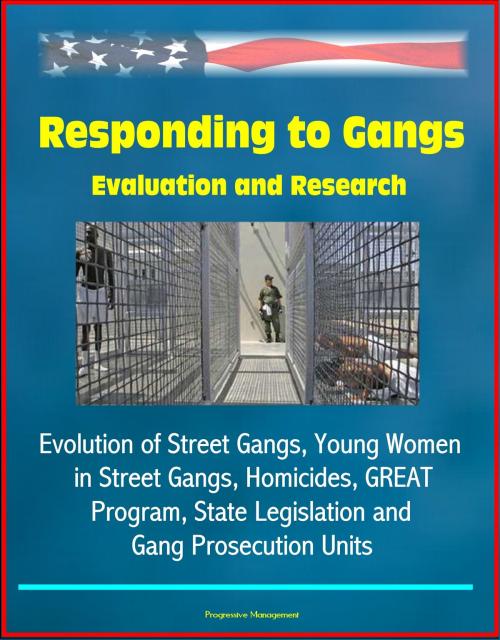Responding to Gangs: Evaluation and Research - Evolution of Street Gangs, Young Women in Street Gangs, Homicides, GREAT Program, State Legislation and Gang Prosecution Units
Nonfiction, Social & Cultural Studies, True Crime| Author: | Progressive Management | ISBN: | 9781311431288 |
| Publisher: | Progressive Management | Publication: | January 26, 2015 |
| Imprint: | Smashwords Edition | Language: | English |
| Author: | Progressive Management |
| ISBN: | 9781311431288 |
| Publisher: | Progressive Management |
| Publication: | January 26, 2015 |
| Imprint: | Smashwords Edition |
| Language: | English |
This collection of papers presents a representative selection of the National Institute of Justice (NIJ) portfolio of gang-related research. The genesis was the upsurge in gang crime beginning in the mid-1980s, which prompted NIJ to expand research in this area. NIJ's major focus is to generate research-based knowledge that can inform policy and be useful for practitioners. For that reason, the emphasis in this volume is on evaluations. An evaluation may indicate a program works or doesn't, but in either case the information can be applied by those seeking solutions to similar problems. The evaluation of Boston's initiative to halt youth gang violence offers hope that focused law enforcement deterrence works. The assessment of the G.R.E.A.T. program demonstrates that school-based prevention can have favorable results. Police chiefs and local policymakers can use evaluation findings to help develop strategy and deploy resources or move in new directions. Not only were the studies in this volume launched with an eye to practice, but some are themselves the product of researcher-practitioner collaboration. Again, the Boston project is an example, with its partnership of local law enforcement and academics tackling youth homicide. Practitioners and researchers working together in Orange County, California, developed a system for tracking gang crime.
In NIJ research, collaboration plays a major role. Through the National Youth Gang Consortium, a coalition of Federal agencies, NIJ works to reduce youth involvement in gang crime. The Consortium is administered by the Office of Juvenile Justice and Delinquency Prevention (OJJDP), an agency with which NIJ has had a long and productive relationship in addressing juvenile offending. In addition to OJJDP, several other Consortium members supported studies in this volume, sponsored the programs evaluated, or otherwise contributed. This pooled expertise in different fields adds to the strength of the volume.
Preface * Chapter 1 - A Decade of Gang Research: Findings of the National Institute of Justice Gang Portfolio * Chapter 2 - The Evolution of Street Gangs: An Examination of Form and Variation * Chapter 3 - Young Women in Street Gangs: Risk Factors, Delinquency, and Victimization Risk * Chapter 4 - Youth Gang Homicides in the United States in the 1990s * Chapter 5 - National Evaluation of the Gang Resistance Education and Training (G.R.E.A.T.) Program * Chapter 6 - Evaluating Nevada's Antigang Legislation and Gang Prosecution Units * Chapter 7 - Evaluation of a Task Force Approach to Gangs * Chapter 8 - Gang Prevention Programs for Female Adolescents: An Evaluation * Chapter 9 - Reducing Gang Violence in Boston * Chapter 10 - Developing a GIS-Based Regional Gang Incident Tracking System
This collection of papers presents a representative selection of the National Institute of Justice (NIJ) portfolio of gang-related research. The genesis was the upsurge in gang crime beginning in the mid-1980s, which prompted NIJ to expand research in this area. NIJ's major focus is to generate research-based knowledge that can inform policy and be useful for practitioners. For that reason, the emphasis in this volume is on evaluations. An evaluation may indicate a program works or doesn't, but in either case the information can be applied by those seeking solutions to similar problems. The evaluation of Boston's initiative to halt youth gang violence offers hope that focused law enforcement deterrence works. The assessment of the G.R.E.A.T. program demonstrates that school-based prevention can have favorable results. Police chiefs and local policymakers can use evaluation findings to help develop strategy and deploy resources or move in new directions. Not only were the studies in this volume launched with an eye to practice, but some are themselves the product of researcher-practitioner collaboration. Again, the Boston project is an example, with its partnership of local law enforcement and academics tackling youth homicide. Practitioners and researchers working together in Orange County, California, developed a system for tracking gang crime.
In NIJ research, collaboration plays a major role. Through the National Youth Gang Consortium, a coalition of Federal agencies, NIJ works to reduce youth involvement in gang crime. The Consortium is administered by the Office of Juvenile Justice and Delinquency Prevention (OJJDP), an agency with which NIJ has had a long and productive relationship in addressing juvenile offending. In addition to OJJDP, several other Consortium members supported studies in this volume, sponsored the programs evaluated, or otherwise contributed. This pooled expertise in different fields adds to the strength of the volume.
Preface * Chapter 1 - A Decade of Gang Research: Findings of the National Institute of Justice Gang Portfolio * Chapter 2 - The Evolution of Street Gangs: An Examination of Form and Variation * Chapter 3 - Young Women in Street Gangs: Risk Factors, Delinquency, and Victimization Risk * Chapter 4 - Youth Gang Homicides in the United States in the 1990s * Chapter 5 - National Evaluation of the Gang Resistance Education and Training (G.R.E.A.T.) Program * Chapter 6 - Evaluating Nevada's Antigang Legislation and Gang Prosecution Units * Chapter 7 - Evaluation of a Task Force Approach to Gangs * Chapter 8 - Gang Prevention Programs for Female Adolescents: An Evaluation * Chapter 9 - Reducing Gang Violence in Boston * Chapter 10 - Developing a GIS-Based Regional Gang Incident Tracking System















